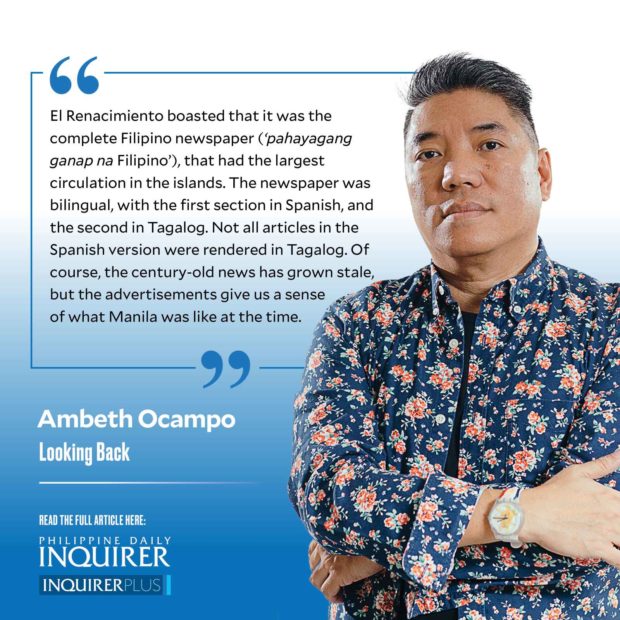Old news reconstructs the past
El Renacimiento (Rebirth or Renaissance) was a newspaper I learned about in college, after reading a translation of Fidel Reyes’ “Aves de Rapiña” (Birds of Prey). While I had come across stray copies during my research, I never gave it a second look after noting that the nationalist newspaper’s name was boldly written in a unique font based on the pre-Spanish syllabary or baybayin. I never browsed any issue of El Renacimiento until Dr. Michael Hawkins, who is also teaching at the University of Michigan Center for Southeast Asian Studies, generously offered his PDF files for the years 1903-1908.
Copies of the newspaper were preserved in microfilm by the US Library of Congress from physical issues filed by the US War Department. Not all issues are extant, and some pages are missing or mutilated in part, making it frustrating to use. El Renacimiento boasted that it was the complete Filipino newspaper (“pahayagang ganap na Filipino”), that had the largest circulation in the islands. The editorial office was located at 56 Concepcion Street, Quiapo, Manila, with Post Office Box 262. The telephone number only had three digits, 345, easier to remember than today’s eight-digit landlines and 12-digit cellphone numbers if you include the country code. Manila subscribers paid P1 a month, foreign subscription cost P2 a month, and provincial subscription cost P4.50 per trimester.
The newspaper was bilingual, with the first section in Spanish, and the second in Tagalog. Not all articles in the Spanish version were rendered in Tagalog. Of course, the century-old news has grown stale, but the advertisements give us a sense of what Manila was like at the time. On the lower part of the front page is an advertisement from the La Germinal tobacco factory that manufactured tabacos (cigars), cigarillos (cigarettes), and picadura (short fill or tobacco scraps) located on Marques de Comilas Street (now Romualdez) by the Ayala Bridge. The other large ads were from Smith, Bell & Co., which sold fire, sea, and life insurance; Bazar Siglo XX on Plaza del Conde, which sold lights and electric doorbells. It also sold all manner of hats: Dante, Yumbo, Vespurcy, Pierrot, Cannotiere, Sampaguita, and Nastros. If Petit Paris on Escolta was a hat and shoe store, also a tailoring shop, then Paris-Manila E. Gutierrez and Company also on Escolta sold Eole soap that was used against mosquitoes, headaches, neuralgia, and skin diseases. The biggest illustrated advertisement was placed by Clark & Co. American Opticians. This firm was not to be confused with the refreshment parlor Clarke on No. 2 Escolta that served lemonade (limonada), sweetened milk (gatas na minatamisan), and ice cream soda (sorbeteng soda).
Then as now, there were a lot of lawyers: Americans like W.A. Kincaid and Allison D. Gibbs, and Filipinos like Eusebio Orense, Carlos Ledesma, Juan Sumulong, Santiago D. Reyes, Leoncio Imperial, Emilio Pineda, even future senator and University of the Philippines president Rafael Palma. With two exceptions all the lawyers operated from Manila except Santiago Lucero of San Isidro, Nueva Ecija, and Ireneo Javier of Laoag, Ilocos Norte. With the American colonial administration came a shift in language from Spanish to English that required translators and teachers. Lope K. Santos, Tagalog editor of El Renacimiento, offered translation services from Spanish and English into Tagalog; also home service Tagalog lessons. A certain Miss Balfe, Profesora de Ingles, offered private classes for ladies and children that focused on English conversation.
Steamers ferried passengers and cargo to Hong Kong run by the China and Manila Steam Ship Co. Domestic lines were run by Compania Maritima which had many steamers: Francisco Pleguezuelo plied Cebu; Butuan for Iloilo; Bolinao for Nueva Caceres and Daet; Venus for Legaspi, Tabaco, and Gubat; Romulus for Palompon, Ormoc, Baybay, Maasin, Malitbog, Surigao, Mambajao (Camiguin), Cagayan de Misamis, and Iligan. Plotting all the destinations on a map reveals how the islands were connected rather than separated by water.
Why browse through outdated news and advertisements in El Renacimiento? These are not trivial, irrelevant details but data and clues historians use to reconstruct or imagine life in Manila in the early 1900s.
Comments are welcome at aocampo@ateneo.edu





















